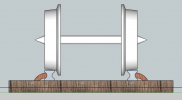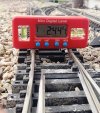You are using an out of date browser. It may not display this or other websites correctly.
You should upgrade or use an alternative browser.
You should upgrade or use an alternative browser.
Derailments
- Thread starter Airbuspilot
- Start date
This suggests to me a track cross-level (twist) issue. I'd carefully check the track across the rails again with a torpedo level in the trouble spots. Don't just check it in a few locations but run the level along the rails checking continuously. It is very difficult to accurately "eyeball" the track for level. Also, I recommend you absolutely avoid any superelevation on your curves (do you Brits call it cant?).usually in the same part of the track and usually a curve
Another thing to check is that the trucks on your bogie wagons properly equalize. One of the truck side frames should be able to rock a bit on the bolster to allow the wheels to follow the rails. This is a design feature - not a loose screw!
Edit added: Make sure the track power is OFF when checking with your level.
Last edited:
Rhinochugger
Retired Oik
Yep, usually because we cant sort it outYes we do call it cant.
Greg Elmassian
Guest
Greg Elmassian
Guest
Both of us need to spend time on our trackwork!
My picture was to show that even seemingly "good looking" track may be way off... I was having derailments after the switch, no wonder!
Greg
My picture was to show that even seemingly "good looking" track may be way off... I was having derailments after the switch, no wonder!
Greg
And very very long trains.Strange, some of my track isn't what most peope would consider level, but I don't get many derailings, most are causedby excessive speed
Not on my line, my line hasn't got room for very, very long trainsAnd very very long trains.
Airbuspilot
Registered
Airbuspilot
Registered
Thank you everyone for your answers and sharing your experience, it has been difficult for me to answer before today. It would have been sensible to take some pictures before I posted but as I don't have immediate access to the railway its probably too late.
All the Locos and rolling stock have the (I assume) standard LGB couplings, most have double some single all the freight wagons have single. All freight wagons had plastic wheels, most very worn, all have now been replaced with metal wheels. The track is exclusively LGB and all end connections are now metal screw types. The track is floating with gravel as ballast, the smallest chip size we can obtain is a bit too large but seems to work OK. The minimum radius is 3 and there are no S turns.
In Jimmy's post No 2 he said check "back to back (40 mm)" I'm not sure what that means?
We cannot run very long trains as we are limited by two of four reverse loop sections, I'm not sure what Greg means by "stringlining" but I assume it relates to longer train lengths dragging the front coaches?
There are several posts offering good ideas regarding the freedom of movement of the wheels, correct installation, lubrication, all of which I will follow up and check. The idea that the hooks can be displaced by having a spring retaining a memory after storage could easily apply here and something I would not have thought of.
it does seem correctly laid track is most likely to be the cause of our problem. Greg's digital level and Malcolm's spirit level wagon are good ideas, thanks for the pictures.
We have one spot which causes derailments on a regular basis and where some carriages flip over. This is at the end of the up/down ramp to the garage storage area, it is at the bottom of a straight track with a down hill gradient followed by a 90 degree bend which has a partial gradient transitioning to level. From what has been said above I guess this is a sure fire way of causing problems if the track is not perfectly laid.
Several people mentioned speed as a factor I think this is also relevant to our operation, I will have to tell my friend the owner to slow down.
Robin
All the Locos and rolling stock have the (I assume) standard LGB couplings, most have double some single all the freight wagons have single. All freight wagons had plastic wheels, most very worn, all have now been replaced with metal wheels. The track is exclusively LGB and all end connections are now metal screw types. The track is floating with gravel as ballast, the smallest chip size we can obtain is a bit too large but seems to work OK. The minimum radius is 3 and there are no S turns.
In Jimmy's post No 2 he said check "back to back (40 mm)" I'm not sure what that means?
We cannot run very long trains as we are limited by two of four reverse loop sections, I'm not sure what Greg means by "stringlining" but I assume it relates to longer train lengths dragging the front coaches?
There are several posts offering good ideas regarding the freedom of movement of the wheels, correct installation, lubrication, all of which I will follow up and check. The idea that the hooks can be displaced by having a spring retaining a memory after storage could easily apply here and something I would not have thought of.
it does seem correctly laid track is most likely to be the cause of our problem. Greg's digital level and Malcolm's spirit level wagon are good ideas, thanks for the pictures.
We have one spot which causes derailments on a regular basis and where some carriages flip over. This is at the end of the up/down ramp to the garage storage area, it is at the bottom of a straight track with a down hill gradient followed by a 90 degree bend which has a partial gradient transitioning to level. From what has been said above I guess this is a sure fire way of causing problems if the track is not perfectly laid.
Several people mentioned speed as a factor I think this is also relevant to our operation, I will have to tell my friend the owner to slow down.
Robin
JimmyB
Now retired - trains and fishing
It is the distance between the backs of the wheels at the flange, too wide can cause the wheel to ride up.In Jimmy's post No 2 he said check "back to back (40 mm)" I'm not sure what that means?

We have one spot which causes derailments on a regular basis and where some carriages flip over. This is at the end of the up/down ramp to the garage storage area, it is at the bottom of a straight track with a down hill gradient followed by a 90 degree bend which has a partial gradient transitioning to level. From what has been said above I guess this is a sure fire way of causing problems if the track is not perfectly laid.
This would indicate that you have a curve on a gradient, or just coming out of a gradient, if your track is level across the track all round this area, then there will be twist in the track. if you get a piece of wood (or simular) 50mm wide and 300mm long that is perfectly flat place it on the track with both end touching, does it wobble, now imagine your carriage and the bogies will all wheels be in contact with the track. I have a similar situation, and it use to cause derailments of certain rolling stock, and adjustment of the track "out of level" is required.
Airbuspilot
Registered
Thanks for the clarification of the wheels, I thought you meant distance between rolling stock which didn't make sense.It is the distance between the backs of the wheels at the flange, too wide can cause the wheel to ride up.
View attachment 304034
This would indicate that you have a curve on a gradient, or just coming out of a gradient, if your track is level across the track all round this area, then there will be twist in the track. if you get a piece of wood (or simular) 50mm wide and 300mm long that is perfectly flat place it on the track with both end touching, does it wobble, now imagine your carriage and the bogies will all wheels be in contact with the track. I have a similar situation, and it use to cause derailments of certain rolling stock, and adjustment of the track "out of level" is required.
I will try the piece of wood idea, by out of level do you mean a slight camber towards the curve centre?
Eeyore.Boater
Registered
Typical string line derailment
The wagons act just like a piece of string pulled (in a chord) across the curve.
JimmyB
Now retired - trains and fishing
If both sides at one end touch both tracks, then there is a good chance that both side at the other end will not touch both tracks, and you will need to "jiggle" the track, to get a good balance between level and 4 point contact, I am sure somebody will have a formulae, but I did mine through trial and error, until I could get my coach to run both ways without derailment.I will try the piece of wood idea, by out of level do you mean a slight camber towards the curve centre?
I agreed and understand
Rhinochugger
Retired Oik
Ooh yuss - that's quite probably a good recipe for mishaps.We have one spot which causes derailments on a regular basis and where some carriages flip over. This is at the end of the up/down ramp to the garage storage area, it is at the bottom of a straight track with a down hill gradient followed by a 90 degree bend which has a partial gradient transitioning to level. From what has been said above I guess this is a sure fire way of causing problems if the track is not perfectly laid.
The solution may increase the adjacent gradients, but ideally I would wish to see something like that dead level (more or less) with any changes in gradient a foot or so away from the curves.
This is largely because radius of curves is one of the key areas where our model trains do not reflect the 1:1 world. In addition, there is the inflexibility of the wheelbase on 4 wheel rolling stock.
Airbuspilot
Registered
A picture is worth a 1000 words, thanks for that. We can only run 5 to 6 coaches, not because of space which we have plenty of but reverse loop length of two sections. It is still a strong possibility for our problem, especially if linked to a track issue.Typical string line derailmentThe wagons act just like a piece of string pulled (in a chord) across the curve.
Airbuspilot
Registered
Thanks Jimmy and RhinochuggerIf both sides at one end touch both tracks, then there is a good chance that both side at the other end will not touch both tracks, and you will need to "jiggle" the track, to get a good balance between level and 4 point contact, I am sure somebody will have a formulae, but I did mine through trial and error, until I could get my coach to run both ways without derailment.
I agreed and understandGreg Elmassian comments about level track, but this is only fully true on level ground with curves, or straight track track on a gradient, add a curve to a gradient, which is often frowned on, but necessary on our garden railways,
It will be difficult to relay the track to make the turn fully flat with a lead in but I think allowing a lean as Jimmy suggests could be a solution, we give it a try.
Robin


